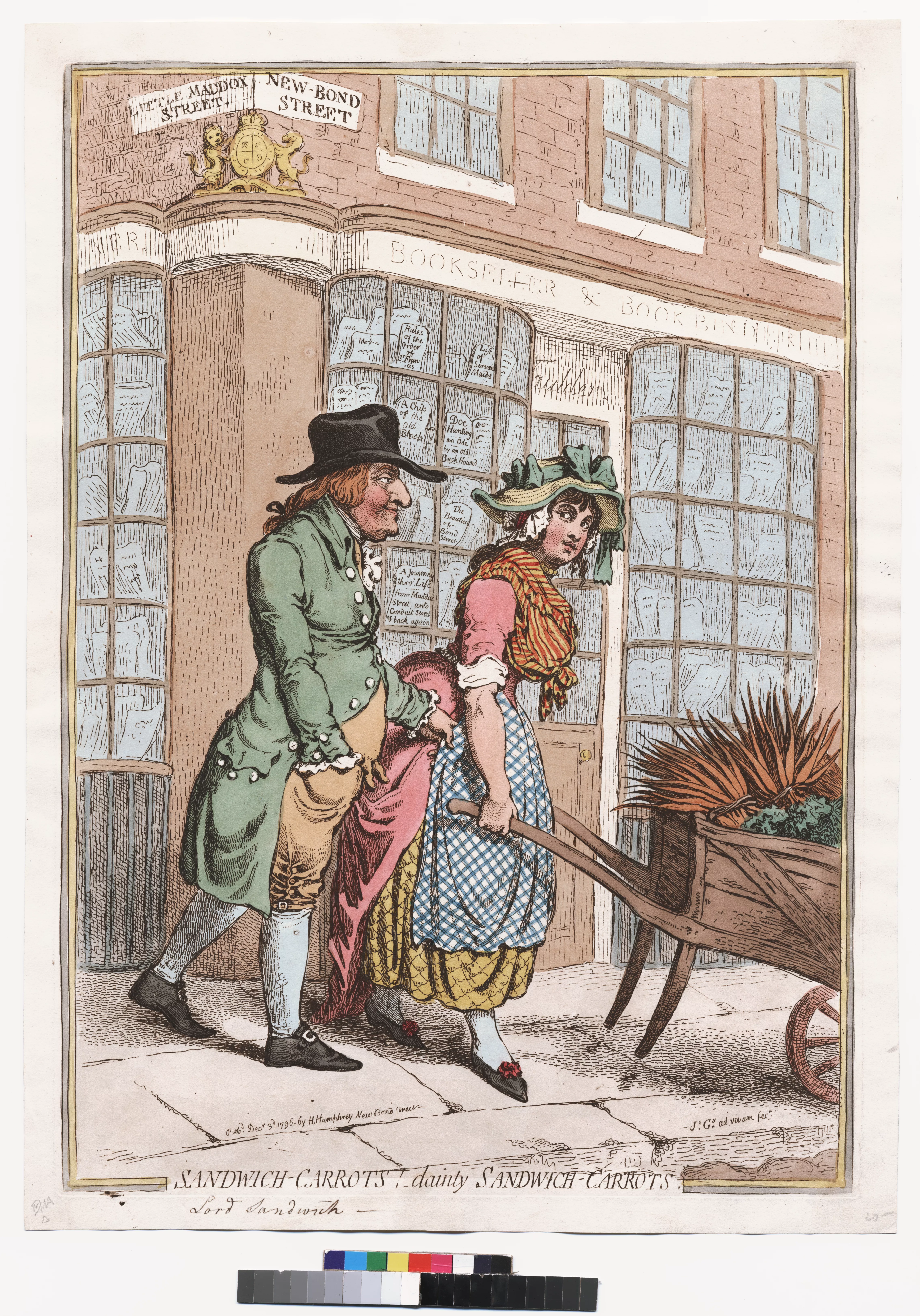Creation Date
3 December 1796
Medium
Genre
Description
At the corner of Little Maddox Street and New Bond Street, a smirking and red-cheeked Lord Sandwich approaches from behind and fondles a young barrow woman selling carrots. The woman’s body is voluptuous and her toe points daintily to the ground as she looks back over her shoulder compliantly. Through his breeches the earl makes a sexually suggestive gesture with the fore- and middle-fingers of his right hand, his left tucked inside the woman’s apron. In the background, Faulder’s bookshop window displays titles such as "Rules of the Order of St Francis," "A Chip of the Old Block," "List of Servant Maids," "Doe Hunting – an Ode – by an old Buck Hound," "The Beauties of Bond Street," "Journey thro’ Life – from Maddox Street unto Conduit Street & back again."
Social caricatures that brought the scandalous pursuits of aristocrats into a comic light catered to the public’s thirst for gossip and featured the morally reproachability of the upper echelons of socieity.
Backgrounded images of text, here the books in Faulder’s window, allude to the the central figures' personal histories and/or current events in which they are concerned. "Rules of the Order of St Francis" identifies Montagu’s father’s participation in the "Franciscan order" founded at Medmenham Abbey, while "Doe Hunting – an Ode – by an old Buck Hound" alludes to the fifth earl’s position as Master of the Buckhounds, which he had held for three years after his election by the Fox-North coalition (W.R. Meyer, "Montagu, John" ). "List of Servant Maids," "Doe Hunting – an Ode – by an old Buck Hound," "The Beauties of Bond Street, Journey thro’ Life – from Maddox Street unto Conduit Street & back again" refer to the nature of the area, known for its frivolousness and fashionabliity and frequented by the “monied loungers” of London (R. Godfrey, The Art 169). The carrots in the barrow serve as a phallic symbol, and by association the barrow a feminine analog; the carrots shape are mimicked by the hand gesture Montagu makes within his breeches. Furthermore, the conventional motifs of mobility (the cart) and economy (sale) in depictions of street women allude to the commodification of the barrow woman’s sexuality. A compliant look back over the shoulder was also a conventional profile for a prostitute in print, here conflating the vendors of everyday goods with those of sex (C. McCreery, Satirical Gaze 41).
More than any other artistic medium, caricature allowed for the explicit intersection of societal spheres, such as the high baron and the low market vendor. Romantic culture’s public thirsted for images of this promiscuity—here conveyed in both its sense of mixing and sexual impropriety. The city was an important vehicle for this medium and in this instance reinforces the increasingly solidified view that the public street was a dangerous place in which a woman could fall into the trap of this promiscuity (D. Donald, Satirical Prints 94), bringing respectable men down with her. This print also makes an important point about the status of prostitution and market vendors in romantic culture; by conflating their iconographies, the print illustrates the economic pressures that forced women who needed to make their profits in the street into moral transgression (C. McCreery, Satirical Gaze 44). Furthermore, this moral transgression had public implications, such that women--both those staying within the domestic sphere and those dangerously treading a visible and unattached life, as the barrow woman in this print--were held responsible for public order, though denied state-sanctioned participation in the public process. In the 1790s, extreme awareness of the societal upheavals in France, British views both narrowed and intensified the importance of female morality in maintaining an ordered society: the threat was a public one, the stakes implicated all of Britain’s honor and order (C. McCreery, Satirical Gaze 4).
Locations Description
Faulder’s bookshop on Little Maddox Street and New Bond Street was about ten yards away from Hannah Humphrey’s print shop (also Gillray’s home) at 37 New Bond Street. The book title referencing Conduit Street further maps out the print’s geographical situation, which had important social connotations: expensiveness, both moral and monetary frivolousness, and fashionability (R. Godfrey, The Art 205).
The “Franciscan Order” at Medmenham Abbey, also known as the Hell-fire Club, was a male libertine organization founded by Sir Francis Dashwood around 1750 after he bought and redesigned Medmenham Abbey in Wycombe, Berkinghamshire. Members engaged in various forms of debauchery, wearing masks and costumes and celebrating mock religious rituals. A river flowed directly into the site, through which the “monks” allegedly escorted prostitutes from London into the premises (M. Bloy, "The Hellfire Club" Victorian Web).
Publisher
Hannah Humphrey
Accession Number
796.12.3.1
Additional Information
Bibliography
Bloy, Marjorie. "The Hellfire Club." Victorian Web: Literature, History, and Culture in the Age of Victoria. 4 March 2002. 28 March 2009 .
Donald, Diana. The Age of Caricature: Satirical Prints in the Reign of George III. New Haven, CT: Yale University Press, 1996.
Godfrey, Richard. James Gillray: The Art of Caricature. London: Tate Gallery Publishing, 2001.
Hill, Draper. Fashionable Contrasts: Caricatures by James Gillray. London: Phaidon Press, 1966.
McCreery, Cindy. The Satirical Gaze: Prints of Women in Late Eigteenth-Century England. New York: Oxford University Press, Inc., 2004.
Meyer, R.W. “Montagu, John, fifth earl of Sandwich (1744–1814).”’ Oxford Dictionary of National Biography, Oxford University Press, Sept 2004; online edn, Jan 2008. 1 April 2009.

